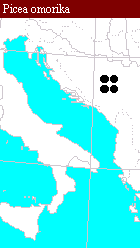Mature cone on a tree in the Seattle Arboretum [C.J. Earle, 2006.02.25].
Foliage on a tree in the Seattle Arboretum [C.J. Earle].
Seedling, showing cotyledons [Raul Conde, 2013.02.14].

Range of Picea omorika (Atlas Florae Europaeae 1998).
Mature cone on a tree in the Seattle Arboretum [C.J. Earle, 2006.02.25].
Foliage on a tree in the Seattle Arboretum [C.J. Earle].
Seedling, showing cotyledons [Raul Conde, 2013.02.14].

Range of Picea omorika (Atlas Florae Europaeae 1998).
Picea omorika
Панчићева оморика, Pančićeva omorika [Serbian], Serbian spruce [English], Ель сербская [Russian], Serbische fichte [German], èpicea de Serbie [French], picea di Serbia [Italian] (Jovanoviæ 1986).
Syn: Pinus omorika Panèiæ 1876.
Narrow-pyramidal, straight tree to trunk 50 m tall. Bark thin, red-brown. First-order branches short (-2 m). Leaves 8-20 mm long, up to 2 mm wide; dark green on the upper side with 2 white stomatal lines on the lower side. Pollen cones light red, yound seed cones violet. Flowers from the end of April to June, depending on habitat. Cones pendant, 5-6 cm long, red-brown, ripening in October and November. Seed 2-3 mm long, with a wing 5-8 mm long. Cotyledons 5-6, 10-12 mm long (Jovanoviæ 1986).
W Serbia and E Bosnia in a small area around the river Drina, on the following mountains: Tara, Zvijezda, Viogor, Radomišlja, Jadovnik. This species was widespread in Europe millions of years ago (known by fossilized remains), but after Pleistocene glaciation it survived only in this refugium. It is found on chiefly calcareous soils at 400-1700 m elevation, usually on steep N-facing slopes. It occurs in pure stands or mixed with Picea abies, Abies alba, Pinus sylvestris, Pinus nigra, Fagus silvatica, Acer spp, Betula pendula, Populus tremula, Ostrya carpinifolia, Sorbus aucuparia, Salix caprea and other species. It sometimes grows in hydric soils with Alnus glutinosa, Picea abies, Abies alba, Fagus silvatica (Jovanoviæ 1986).
Hardy to Zone 5 (cold hardiness limit between -28.8°C and -23.3°C) (Bannister and Neuner 2001).
The largest recorded specimens are in horticulture. A tree 72 cm DBH and 31.50 m tall was measured at Murthly Castle, UK, in May 2017; at that time it was 122 years old (Monumental Trees, accessed 2019.11.12); it is also the second-tallest tree known. A tree 33 m tall (in 2014) occurs at the Arboretum Mustila in Finland (Monumental Trees, accessed 2019.11.12).
The oldest known living specimen, 226 years, was documented in a tree-ring chronology covering the period 1856-1981 (crossdated after 1864), collected near Cakor Pass, Montenegro by Fritz Schweingruber and colleagues (doi.org/10.25921/ny84-8c22). There is only one recorded collection of this species, and considerably older trees may exist.
Its wood is similar to that of the common European spruce Picea abies. It is widely planted as an ornamental tree in central and northern Europe and North America, and is sometimes used in forestry in these areas (Jovanoviæ 1986). It is exceptionally suitable to horticultural applications, being tolerant of poor soils, fast-growing to a height of about 50 feet, and tolerant of air pollution (Johnson 1993).
The species has seen some use in dendrochronology. For instance, Trouet (2014) reports on use of a chronology developed at Cakor Pass, Montenegro, and its use in a summer temperature reconstruction.
Most natural occurrences are on steep slopes or in ravines where access is difficult. Drive-up access is feasible at two locations in Serbia's Tara National Park, Zmajevski Potok and Trenice; for photos, access and further information see Monumental Trees (accessed 2019.11.12). These localities have experienced selective logging, so there are no particularly large individuals, but the trees occur in mixed stands with other conifers including Picea abies, Pinus sylvestris, and Pinus nigra. Picea omorika stands are the only places in Europe where it is possible to see two spruce species growing naturally side-by-side (contributed by Kouta Rasanen, 2019.11.12).
The epithet was designated by Pančić, and is a local name for the tree.
It was logged until the early 20th century, but the few remaining small stands are protected (Jovanoviæ 1986). The Conifer Specialist Group (1998) reports that it known from fewer than 1000 trees, occurring on 60 ha of forest in Pancic Narodni Nature Reserve in the Tara Mts. The only threat appears to come from competition with P. abies and Fagus orientalis (Johnson 1993).
Atlas Florae Europaeae. 1998. Computer program formerly available for download at http://www.fmnh.helsinki.fi/english/botany/afe/index.htm, accessed 2009.04.17, now defunct.
Conifer Specialist Group. 1998. Picea omorika. In: IUCN 2006. 2006 IUCN Red List of Threatened Species. www.iucnredlist.org (accessed 2006.09.28).
Johnson, Hugh. 1993. The International Book of Trees. London: Mitchell Beazley.
Jovanoviæ, Branislav. 1986. "Picea omorika," in Flora Srbije. Belgrade: Serbian Academy of Sciences and Arts.
Purkyne, E. von. 1877. Eine asiatische Conifere in den Balkanländern. Oesterr. Monatsschrift für Forstwesen Wien 27:446.
Trouet, Valerie. 2014. A tree-ring based late summer temperature reconstruction (AD 1675-1980) for the northeastern Mediterranean. Radiocarbon 56(4):S69-S78.
Elwes and Henry 1906-1913 at the Biodiversity Heritage Library (Photo). This series of volumes, privately printed, provides some of the most engaging descriptions of conifers ever published. Although they only treat species cultivated in the U.K. and Ireland, and the taxonomy is a bit dated, still these accounts are thorough, treating such topics as species description, range, varieties, exceptionally old or tall specimens, remarkable trees, and cultivation. Despite being over a century old, they are generally accurate, and are illustrated with some remarkable photographs and lithographs.
The species account at Threatened Conifers of the World.
Thanks to Milan Jovanovic for information and assistance contributed 1999.02.
Last Modified 2023-11-03